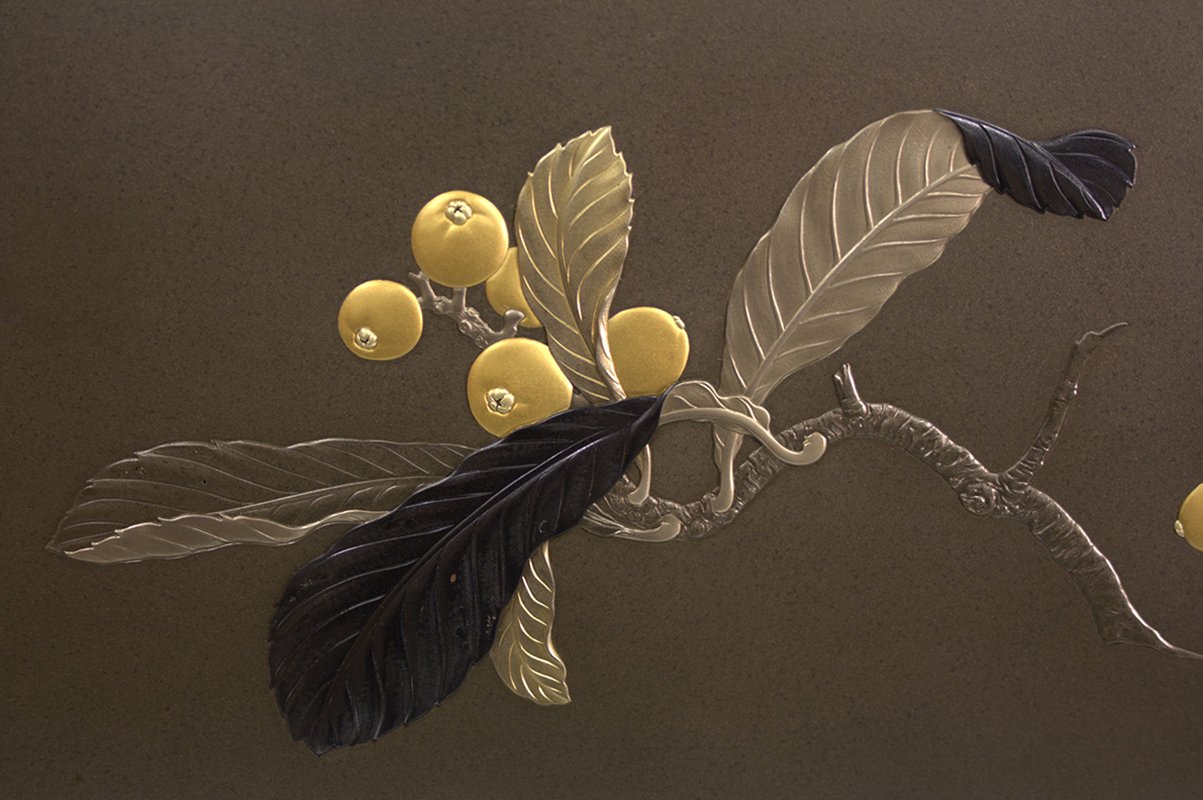MEIJI-TAISHO
ITO MASAMI, 1922 GOLD PRIZE EXHIBITION PAIR OF INLAID PLAQUES WITH FRUIT
Pair of rectangular plaques with a design of a branch of fruiting pomegranate and Buddha’s Hand citron on the right-hand, and of a branch of Biwa fruit and a poem on the left-hand plaque. Signed on the right hand plaque with a chiseled signature by the artist: Masami, and with an inlaid gold seal: Masami (Ito Masami, active late Meiji – Taisho era). Each plaque of shibuichi, hammered, carved and inlaid in two different alloys of shibuichi, in silver, red bronze, shakudo and two colors of gold. Mounted on gold backed silk fabric in kurogaki or black persimmon wood frames. Taisho 11 or 1922.
With the tomobako or original box, inscribed on the reverse of the lid: Rogin Ji Ita San Seika No Zu, Ittsui Gaku Men, Chokoku Hei Zu Ito Masami, Shisan Heisho Yume Hokusui or Pair of Shibuichi Plaques with Designs of Three Kinds of Fruit, Carved by Ito Masami, Calligraphy by Yume Hokusui. The inscription continues: Heiwa Hakurankai Bijyutsukan Ni Shuppin Shite Itto Sho Kinpai No Hosho O Jyuyo Serraru, Taisho Jyuichi Nen Shichigatsu Toka or Made for Exhibition at the Peace Exhibition, and Awarded the Gold Prize, Taisho 11th Year (1922) July 10, and signed: Masami and sealed: Masami.
From the collection of the descendants of Asaka No Miya or Prince Asaka.
Born in Tokyo the son of Takeda Nobutoshi, Ito Masami was later adopted by Ito Katsumi. Masami was a member of the Tokyo Chukinkai (Tokyo Metal Casting Association) and resided in the Okachimachi area of the Shitaya district of Tokyo. He was active during the Meiji and Taisho eras, and his high-level metal art drew the patronage of the Imperial Household Agency.
A pair of Imperial presentation vases by Ito Masami in the Khalili Collection is illustrated in Splendors of Meiji: Treasures of Imperial Japan, Masterpieces from the Khalili Collection, page 361, number 380.
Ito Masami, 1922 Gold Prize Exhibition Pair of Inlaid Plaques with Fruit
Artist Name: Ito Masami
Period: Meiji Taisho
Mediums: Metalwork
Origin Country: Japan
16 ½” high x 31 ¼” wide, dimensions of each frame
This piece is no longer available.








